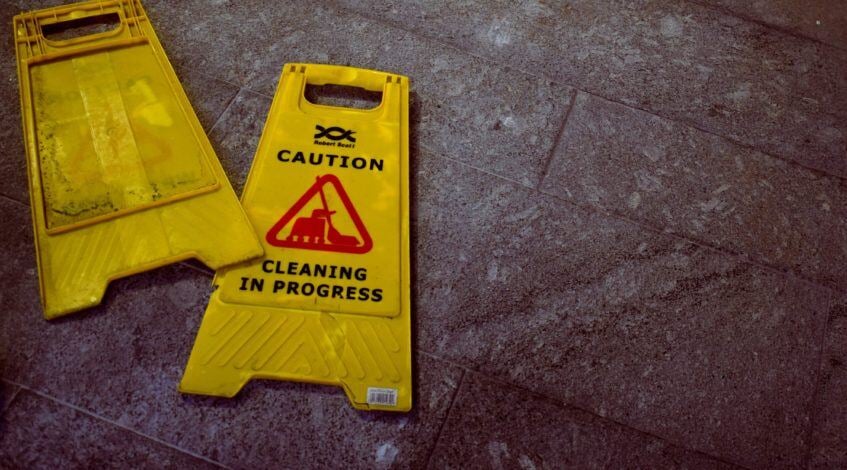In 2019, there were 5,333 fatal work injuries, up 2% from the previous year. Meaning 14 workers are killed on the job each day. Although accidents occur, the Occupational Safety and Health Administration (OSHA) enforces safety laws that reduce health and safety risks. As a business owner, it is your responsibility to ensure that your employees’ workplace is safe and free of recognized health hazards.
The goal here is to take a proactive approach to protect both you and your employees. One slip and fall accident that you are found to be responsible for due to negligence could put your company out of business. That is why you need to develop an effective workplace safety program. Being proactive today could ensure your business’s success for years to come.
What Is a Workplace Safety Program?
A workplace health and safety program helps you develop a good safety culture. This type of program is a well-planned, written document highlighting the potential hazards in your workplace and what you plan to do to control those risks. Such a program’s ultimate objective is to integrate health and safety proactively into all of your workplace practices and conditions.
As stated by the United States Department of Labor, “a safe workplace is a sound business.”
Creating a workplace safety program is the first step toward ensuring compliance and your company’s ongoing success. The following steps will help you develop a workplace safety program that brings you and your employees greater peace of mind.
Read more: 9 Benefits of Using a PEO During a Crisis
1. Be Aware of the Updates Made to the Guidelines for Safety and Health Programs
First released 30 years ago, OSHA recently updated the Guidelines for Safety and Health Programs. The updates reflect the significant changes in workplaces and the economy and the evolving health and safety issues. Designed to support a broad spectrum of small and medium-sized businesses, the latest recommended practices are based on seven core elements:
- Management leadership.
- Worker participation.
- Hazard identification and assessment.
- Hazard prevention and control.
- Education and training.
- Program evaluation and improvement.
- Communication and coordination for host employers, contractors, and staffing agencies.
Besides preventing workplace injuries and illnesses, these practices will also improve compliance, reduce costs, engage workers, enhance social responsibility, and increase productivity.
2. Assess Workplace Risks
There are select industries that are particularly dangerous, such as warehousing, construction, manufacturing, and transportation. However, injuries can occur at any job. For example, working as a nurse wouldn’t seem overly risky. Yet, according to the U.S. Bureau of Labor Statistics, hospital workers have a higher rate of injury and illness than those who work in construction and manufacturing. This is because of joint sprain and strain injuries related to moving patients.
While creating your company, it is essential to analyze your workplace for everyday hazards. It is highly recommended that you seek a professional assessment. You can also conduct an anonymous employee survey. This provides your employees with an opportunity to express their concerns. During your evaluation, consider workplace hazards (e.g., the layout of your workplace), activity hazards (e.g., machine- or height-related risks), and environmental hazards (e.g., health risks or issues with air quality).
Take the PEO test to learn how America’s Back Office can help your organization.
3. Create a Written Document
Once you have assessed your workplace to identify hazards, it’s crucial to create a written document. This document must include all employee job descriptions, highlighting all health and safety responsibilities. You must provide this to employees in a written and detailed manner to ensure accountability. The last thing you want is for an accident to occur, and there be any confusion in terms of liability because you were not clear.
America’s Back Office offers a selection of customizable HR solutions. Get a quote here.
4. Implement and Adapt
If, after writing your latest workplace safety program, there are any changes, it’s essential to train all employees so that they can recognize hazards — even those who have already completed their initial training. As time goes on, you must investigate if any accidents occur, no matter how minor. Also, be sure to welcome suggestions in terms of ongoing safety. Your employees may spot potential hazards you missed.
How America’s Back Office Can Help
Whether you require support for workers’ compensation, payroll, employee benefits, or workplace safety, America’s Back Office can assist you and your unique needs. If you seek a professional assessment, we will help you identify health and safety risks within your workplace. That way, you can create a program that ensures compliance. We also assist our clients with their training needs.
To get started, check out our turnkey HR solutions and schedule a free face-to-face consultation today!






